

Introduction to Timatic – All Your Visa Questions Answered
This blog post introduces Timatic, a tool used by airlines to ensure travelers have valid documents before traveling to a foreign country. The post explains how to use the tool and provides examples for different scenarios. The author emphasizes the importance of understanding visa requirements and suggests that Timatic is a valuable addition to any traveler’s resources.
Navigating visa requirements for international travel can be a confusing and complex process. Various factors, including the traveler’s nationality, destination country, existing visas, travel dates, guidelines for return tickets and length of stay, transit countries, recent travel history, and purpose of visit, can all impact the requirements for obtaining a visa. These guidelines can vary greatly from country to country and can change over time.
Given the extensive and ever-changing nature of visa requirements, airport check-in staff cannot be expected to remember all possible combinations of rules that apply to each traveler. For this reason, airlines rely on a reliable tool called TIMATIC to ensure travelers have valid documents before transporting them to a foreign country. Failure to comply with visa requirements can result in heavy penalties for airlines.
Enter Timatic & TravelDoc
Timatic – Travel Information Manual Automatic is a tool operated and maintained by the International Air Transport Association ( IATA ). Most airlines subscribe to it to provide their staff with the latest travel requirements before issuing a boarding pass to passengers. Although airlines have to pay for access to this information, some airlines or alliances, provide public access to the tool for individuals to use to address their visa confusion.
TravelDoc is a competing offering to the IATA Timatic but a large part of the data is obtained from Timatic itself, I prefer to use TravelDoc over the Timatic interfaces since I find it more user-friendly, you can use either.
Today, we will be using the SkyTeam TravelDoc tool for the examples below. Alternatively, you can also use Emirates or even Vistara Timatic interfaces.
When you access https://skyteam.traveldoc.aero/ , you will see a page that is mostly self-explanatory. However, for the sake of this demonstration, we will explore two different scenarios.
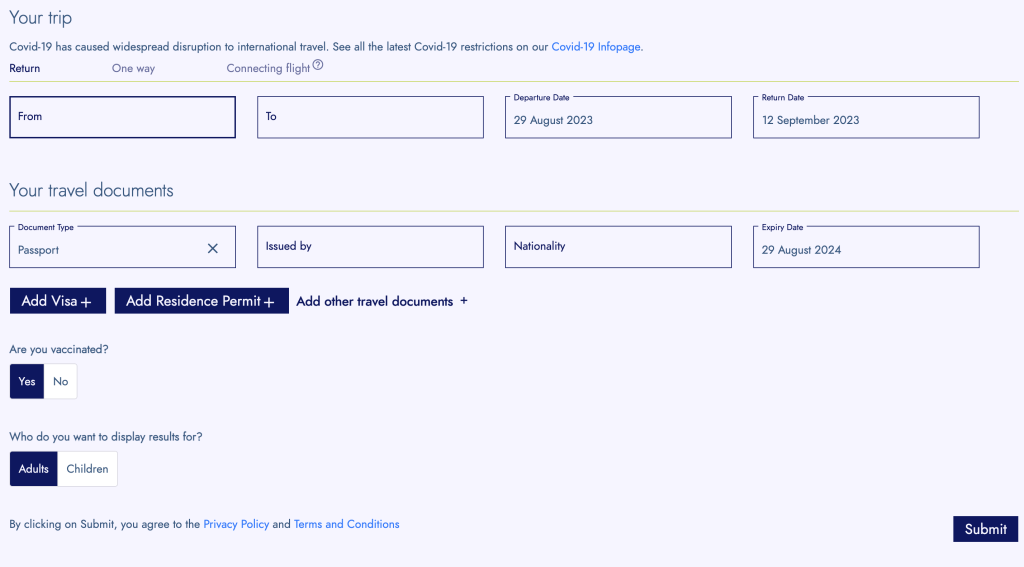
Scenario 1 – Using TravelDoc
An Indian passenger with an Indian passport is traveling from Delhi (DEL) to London (LHR), transiting through Frankfurt (FRA). He is flying with Lufthansa and has a UK visa but does not have a Schengen, US, or any other visa.
I filled up the details as can be seen below, since he has a connecting flight at FRA make sure you fill these details up under the Connecting Flight tab and not the One Way or Return .
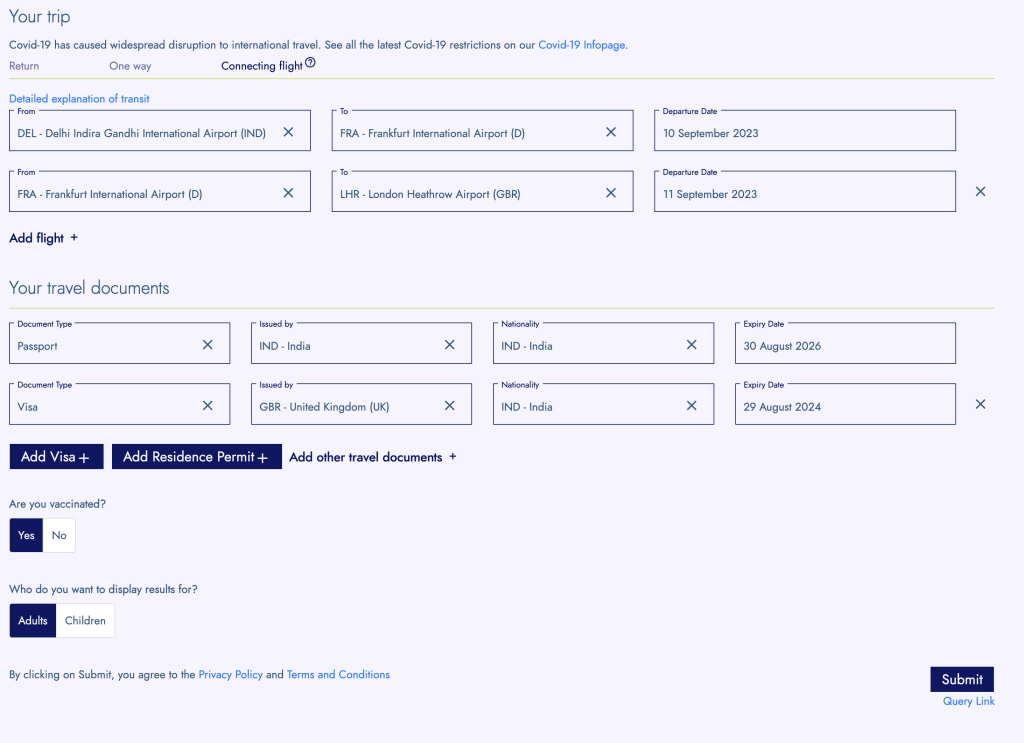
On the next page, it asks me if I have any additional documents for the DEL – FRA leg. For the sake of this example, I will select, “I don’t have an additional document”.
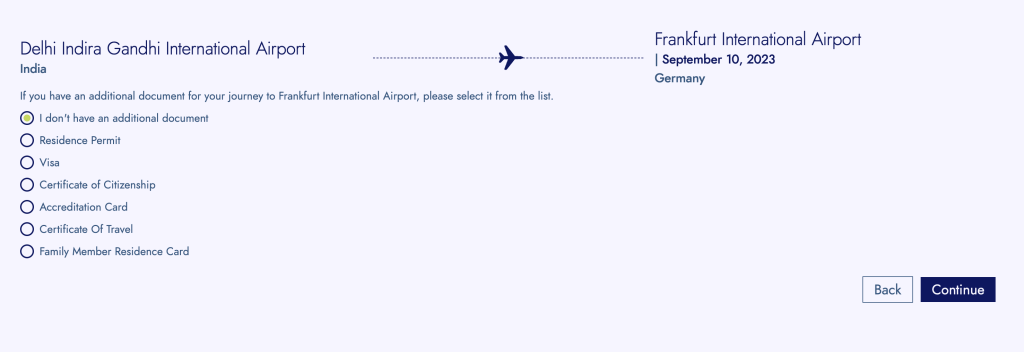
The next page gives us the result and as expected, you are not allowed to board the DEL – FRA flight due to transit requirements at FRA. This is precisely what your check-in agent at DEL airport would also see when checking you in for the flight.
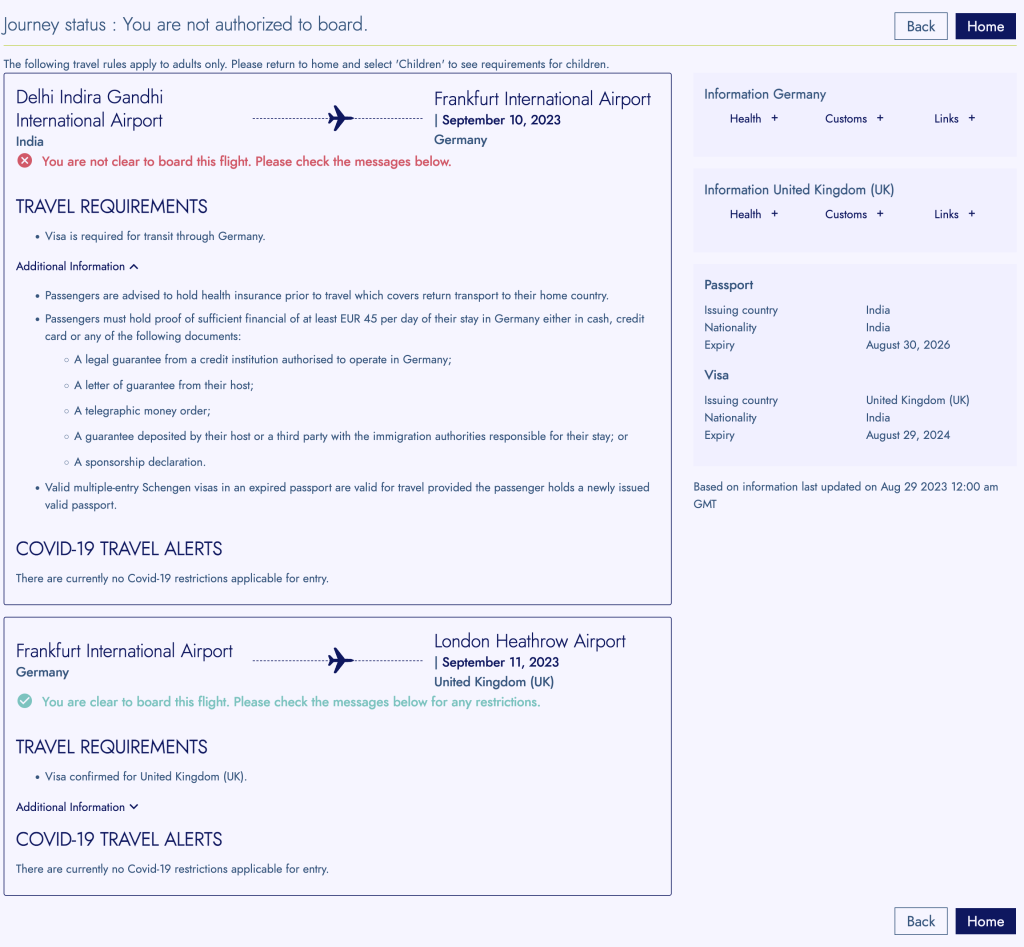
Now let us go back to the first page once again and add that the passenger has a valid US Visa.
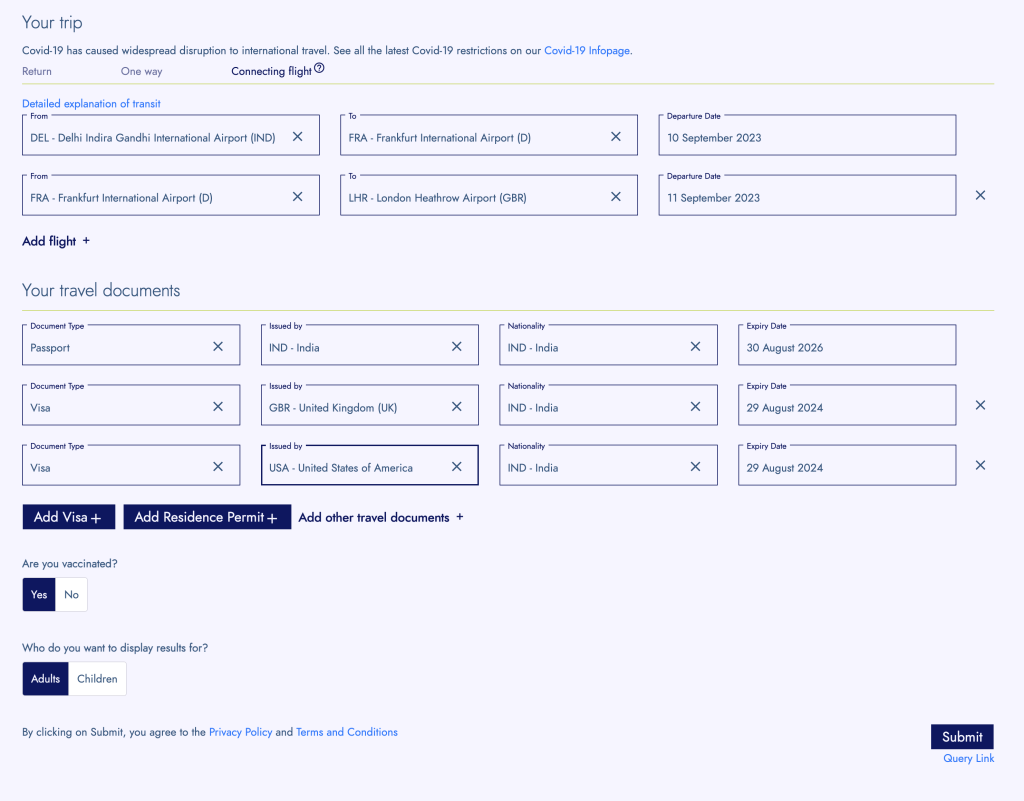
As you can see under Travel Documents I have added a US visa, let’s see how this changes the results.
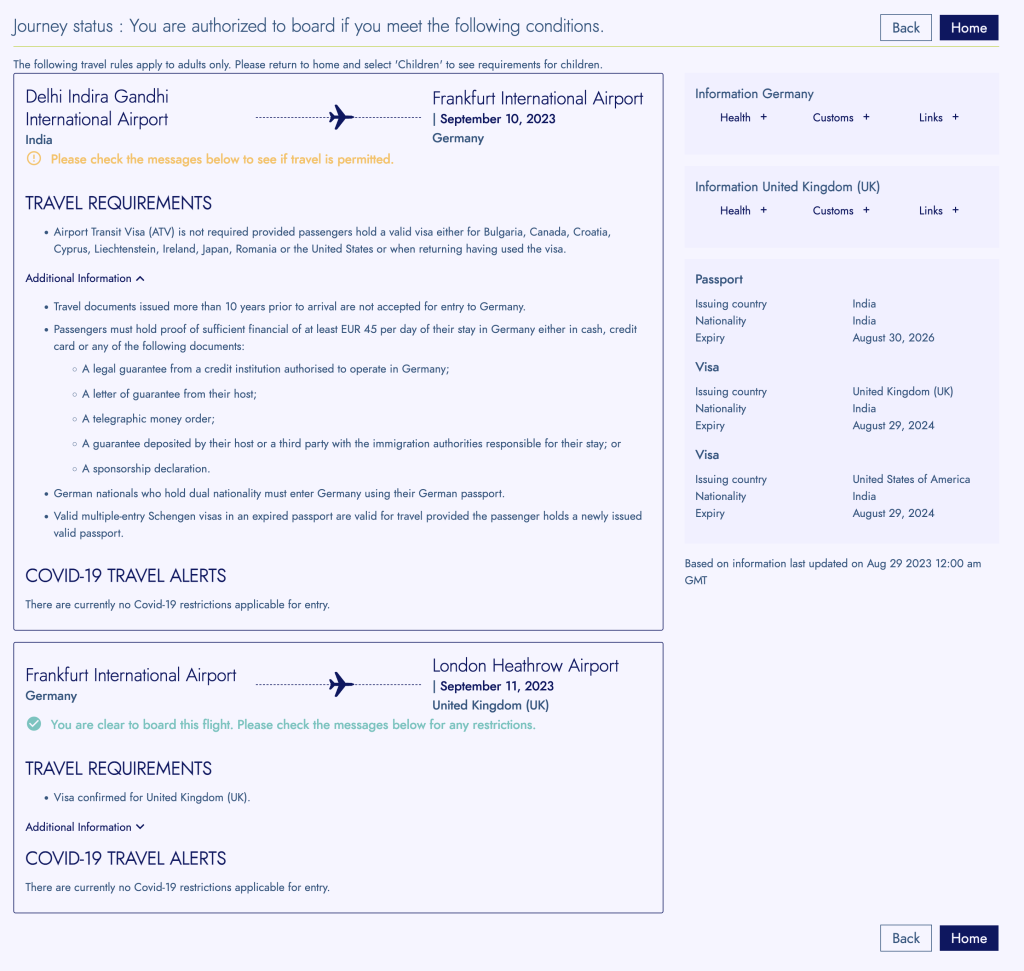
As can be seen, holding a US visa waives the requirement for an Airport Transit Visa (ATV) at Frankfurt (FRA).
Scenario 2 – Exploring Singapore VFTF using Timatic
If you are from India and in transit to or from a third country via Singapore, you may be eligible for the 96-hour VFTF if you enter Singapore by any mode of transport but depart only via air or sea. You must have a valid onward air/ferry/cruise ticket departing Singapore within 96 hours, and a valid visa or long-term pass issued by any of the following countries: Australia, Canada, Germany, Japan, New Zealand, Switzerland, United Kingdom, or United States of America. You must travel directly from the country that issued the SJV, en route through Singapore, back to your home country, and not have returned to your home country since you last used the SJV.
For this example, we will try and explore the Singapore Visa Free Transit Facility (VTFT). For this example, our passenger is flying from Delhi (DEL) to Singapore (SIN) and then onward to Indonesia with a 48-hour stay in Singapore. The passenger holds an Indian passport with a valid US visa and qualifies for Visa on Arrival in Indonesia.
We fill up these details, once again under the connecting flight tab.
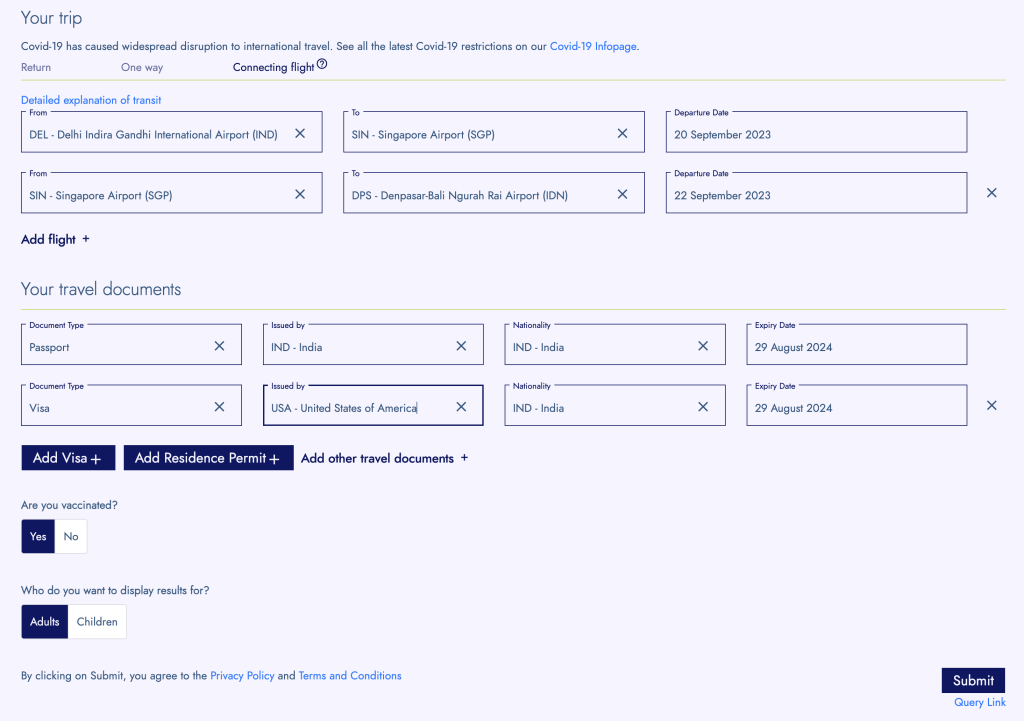
Here are the results.
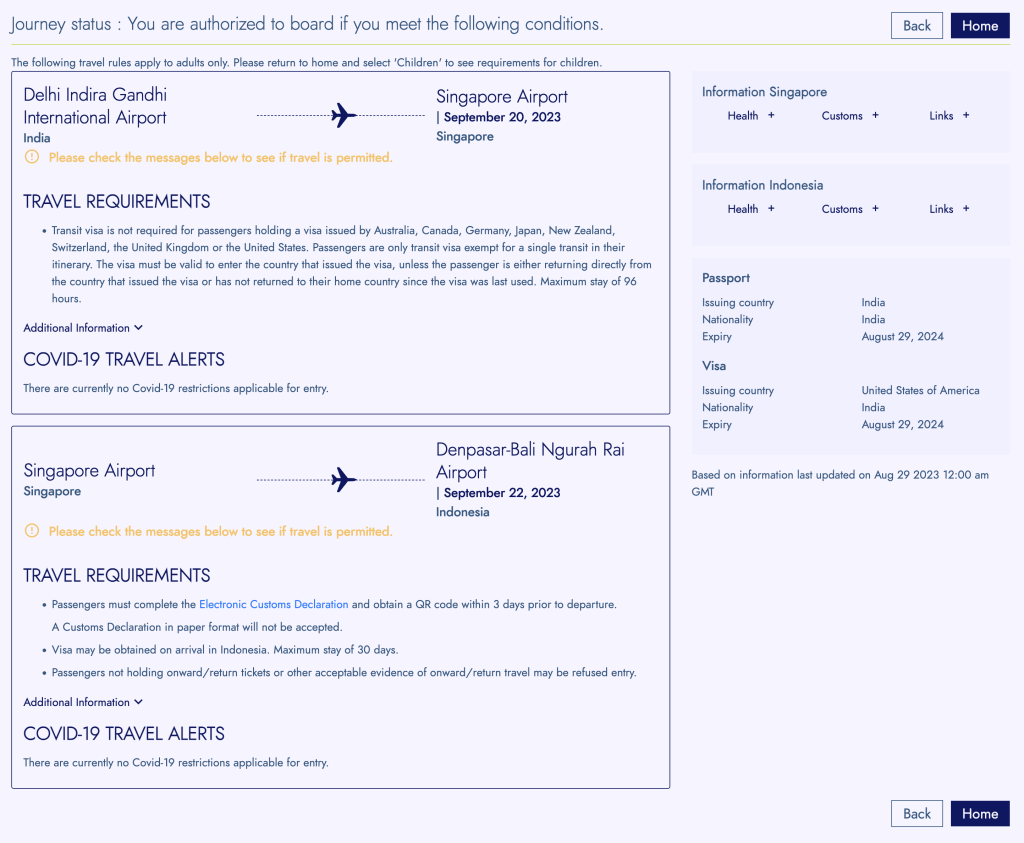
Timatic & TravelDoc are both highly useful tools for answering all your visa-related questions. It provides accurate and up-to-date results. Surprisingly, it is not widely known or written about and is severely underutilized by passengers. While it is always recommended that you obtain visa information from the respective embassies, these are both a great addition to your travel arsenal.
🔔 Signup for Instant Alerts
Some of our content can be time-sensitive such as limited-time deals or offers. Subscribe to our email alerts to receive an email as soon as a new post is published. No spam, no ads. Pinky promise!
You’ve been successfully subscribed to our newsletter!
A jack of all trades, master of none. With over 200+ award night stays across a myriad of hotel chains and 50+ flight redemptions and counting his mantra in the game is “earn and burn”. Owing to his inherent laziness Jay firmly believes in simplifying the award game for all and focuses on simple, straightforward, practical yet memorable redemptions over outlandish RTWs and other complicated terminologies.
Share with friends
You might also like.
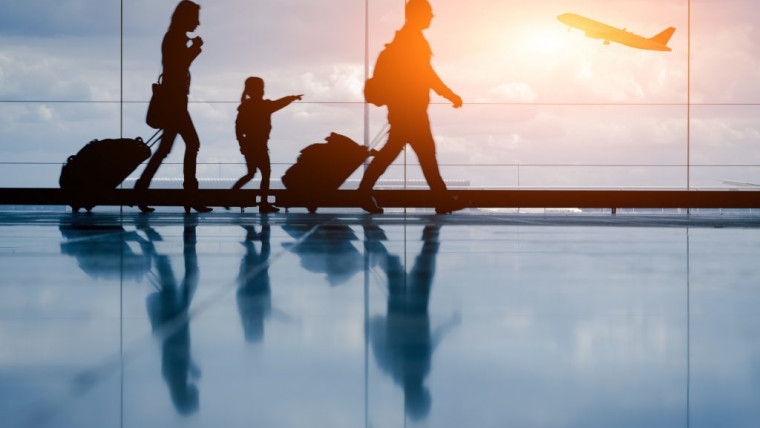
Miles for Dummies: Family Pooling

Best Credit Cards to Buy Apple Products in India
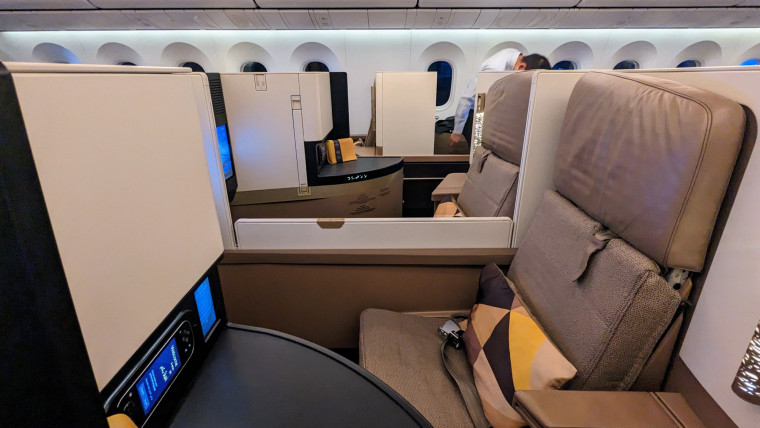
Etihad Business Studio Review – Is the lost mojo back?

An African Safari On Points: A Tryst with the Wilderness
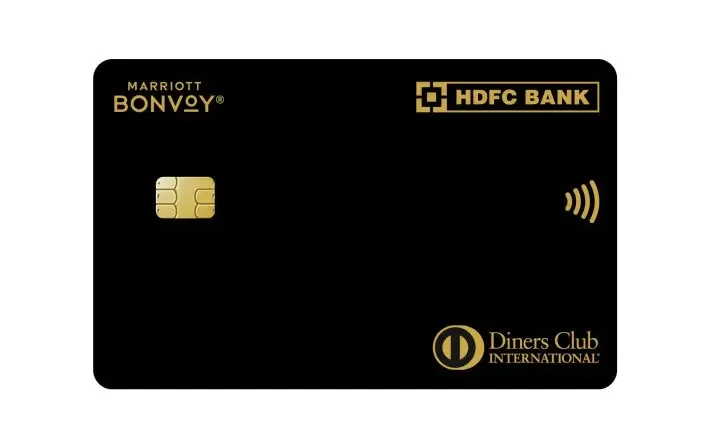
HDFC Marriott Bonvoy Card – First Impression & Review
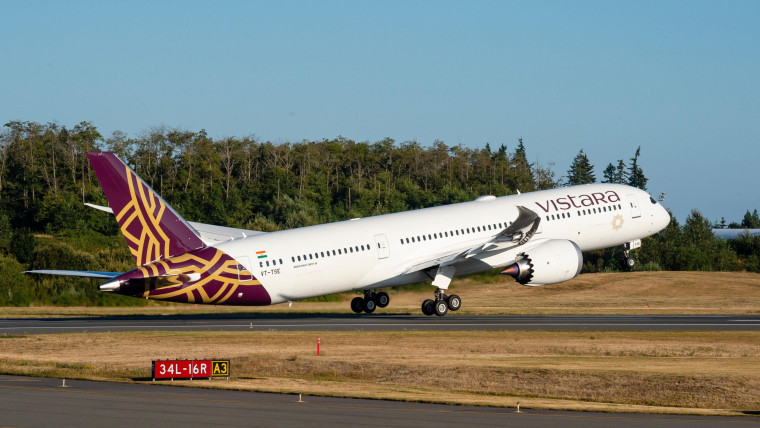
A Limitless Expanse on Club Vistara: Ultimate Guide to Earning and Burning CV Points
One reply to introduction to timatic – all your visa questions answered.
Nice Article Jay , Very Informative !!
Leave a Reply Cancel reply
Your email address will not be published. Required fields are marked *
Save my name, email, and website in this browser for the next time I comment.
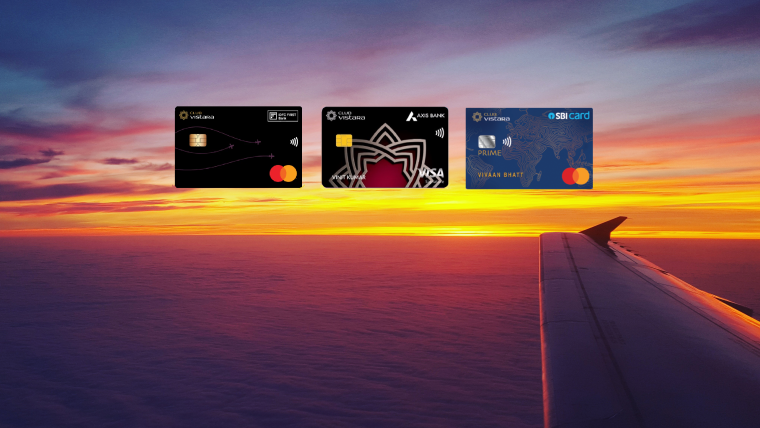
Club Vistara IDFC First Vs SBI Vistara Prime Vs Axis Vistara Signature
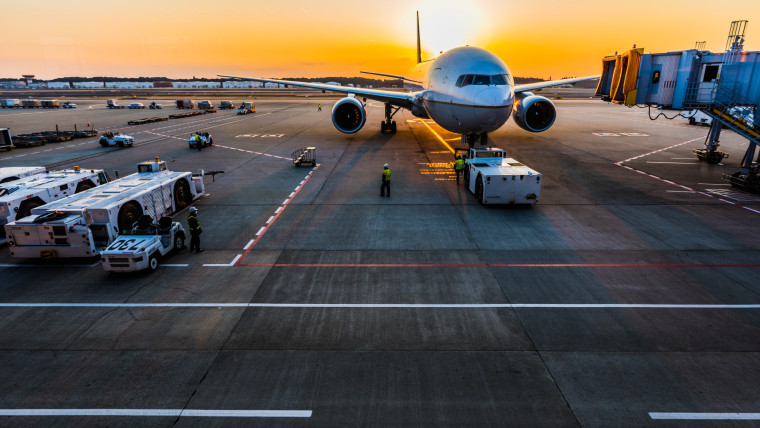
How long does it take to transfer Axis Edge Reward Points?
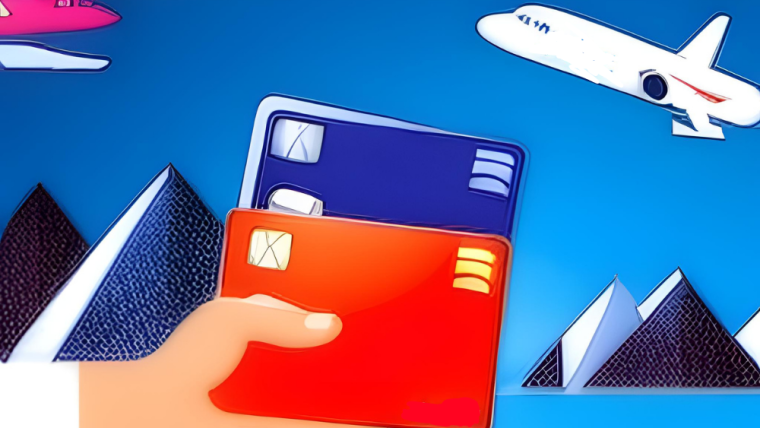
Best Credit Cards to Earn Airmiles in India
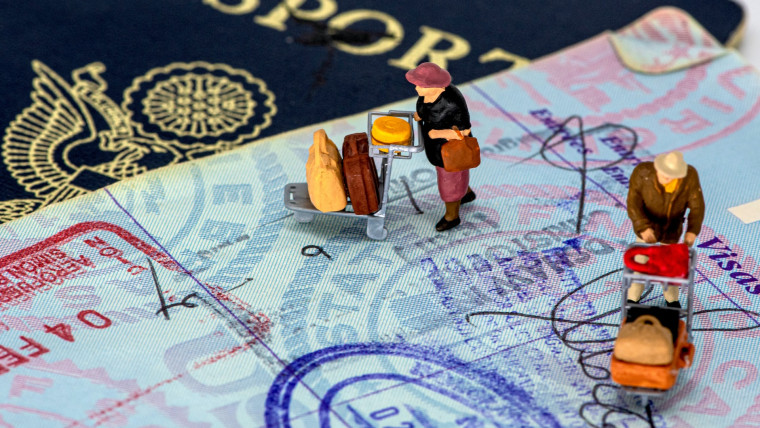
IATA Timatic: Managing Passenger Passport and Travel Document
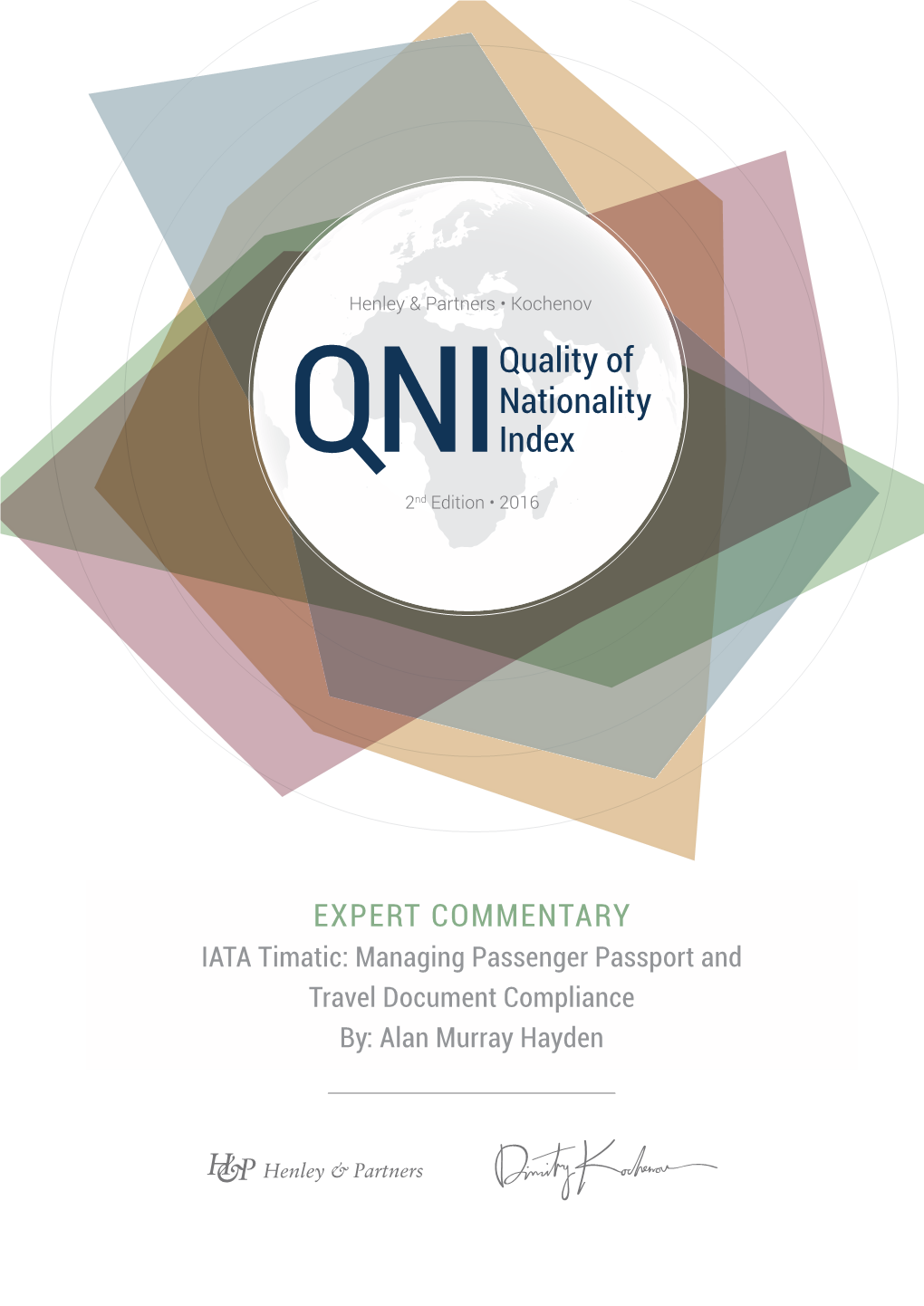
The Henley & Partners - Kochenov
EXPERT COMMENTARY IATA Timatic: Managing Passenger Passport and Travel Document Compliance By: Alan Murray Hayden Henley & Partners – Kochenov Quality of Nationality Index • 2nd Edition 2016 IATA Timatic: Managing Passenger Passport and Travel Document Compliance
IATA Timatic: Managing Passenger Passport and Travel Document Compliance
Alan Murray Hayden IATA, Netherlands
The International Air Transport Association (IATA) is the trade association for the world’s airlines , representing some 267 airlines or 83% of total air traffic. IATA supports many areas of aviation activity and helps formulate industry policy on critical aviation issues. IATA helps airlines operate safely, securely, efficiently and economically under clearly defined rules. Professional support is provided to all industry stakeholders, with a wide range of products and expert services. The IATA Timatic database is a one-stop shop for reliable and up-to-date visa immigration rules information. Having cooperated with Henley & Partners on the HVRI – looking at the number of destinations an adult holder of any ordinary passport can visit visa-free or with a visa-on-arrival for a short-term stay, in 2015 IATA extended its cooperation with researchers to contribute data also to the QNI, providing an array of crucially important datasets for the production of the QNI, which you are holding in your hands.
Why Do Airlines Check Passengers' Travel Documents?
Have you ever wondered why airlines check your passport? After all, it is not as if they really mind what nationality you have… In short, it is the airline ’s responsibility to ensure that every passenger has sufficient travel documents for their destination and any transit points. Where airlines do not perform this task, or mistakenly carry a passenger with insufficient travel documents, they will normally be fined by the Immigration Department, with such fines reaching into the thousands of dollars.
The vast majority of rejections are for three reasons:
1 Passport validity – each country demands that travelers' travel documents must be valid for a certain length of time, and in many cases it will vary by the nationality of the passenger Henley & Partners – Kochenov Quality of Nationality Index • 2nd Edition 2016 IATA Timatic: Managing Passenger Passport and Travel Document Compliance
IATA Timatic: Managing Passenger Passport and Travel 2 One-way tickets – most countries have regulations that non-nationals must have a return or onward ticket showing that they do not intend to stay in the destination country; however, few Document Compliance actually enforce this 3 Visa – passengers do not have a visa or it is invalid. This is becoming an increasingly complex area as many countries are starting to accept visas issued by other countries, e.g. Mexico will accept US visas
Airlines are also protecting their travelers from taking a flight where they will not be admitted to the destination country. Can you imagine a couple going on a long-awaited vacation and being refused entry to their holiday destination as their passports expire in five months, whereas the destination country requires them to be valid for six months?
Alan Murray Hayden IATA TIM and Timatic
IATA, The Travel Information Manual (TIM) and Timatic are two IATA products which help airlines and other Netherlands actors operating within the international airline arena manage passenger travel document compliance. The TIM and Timatic range of solutions contains immigration regulations covering the following areas:
• Passport regulations and recommendations • Visa regulations and recommendations IATA • Health regulations and recommendations The International Air Transport Association (IATA) is the trade association for the world’s airlines, • Airport tax to be paid by the traveler at either departure or arrival airport representing some 267 airlines or 83% of total air traffic. IATA supports many areas of aviation activity • Customs regulations relating to import/export of goods and small pets by a passenger and helps formulate industry policy on critical aviation issues. IATA helps airlines operate safely, • Currency regulations relating to import and export by a passenger securely, efficiently and economically under clearly defined rules. Professional support is provided to all industry stakeholders, with a wide range of products and expert services. The IATA Timatic database is The TIM was first launched in 1954, and is still published and distributed to thousands of users around a one-stop shop for reliable and up-to-date visa immigration rules information. Having cooperated with the world every month. It was followed in 1985 by Timatic, which is an electronic version integrated Henley & Partners on the HVRI – looking at the number of destinations an adult holder of any ordinary into airline and travel agent reservation systems. Since then, the product has continued to develop passport can visit visa-free or with a visa-on-arrival for a short-term stay, in 2015 IATA extended its with web-based versions. However, such manual systems are inefficient and require passengers to cooperation with researchers to contribute data also to the QNI, providing an array of crucially important queue up to have their documents checked, as we have all experienced at some time in our life. datasets for the production of the QNI, which you are holding in your hands.
Why Do Airlines Check Passengers' Travel Documents? Self-service Check-in: Simplifying the Passenger’s Travel Experience
Have you ever wondered why airlines check your passport? After all, it is not as if they really mind In 2006 Timatic AutoCheck was launched, which combines the Timatic data with a rules engine, what nationality you have… In short, it is the airline’s responsibility to ensure that every passenger has thereby enabling airlines and travel agents to automate the travel document check as part of the sufficient travel documents for their destination and any transit points. Where airlines do not perform check-in process, and to provide personalized travel document advice to passengers at the time of this task, or mistakenly carry a passenger with insufficient travel documents, they will normally be reservation. fined by the Immigration Department, with such fines reaching into the thousands of dollars. Timatic AutoCheck works by having the passenger or agent scan their passport or travel document The vast majority of rejections are for three reasons: as part of check-in. This travel document data is then combined with the itinerary information, and 1 Passport validity – each country demands that travelers' travel documents must be valid for a submitted to Timatic AutoCheck for processing. An instant response is sent back to the airlines as certain length of time, and in many cases it will vary by the nationality of the passenger to whether the travel documents are sufficient, and if not, why not. In the majority of cases a positive response is sent back and the passenger can continue with check-in without even being aware that the document check was performed. Only where there is an issue is the passenger directed to an agent. Henley & Partners – Kochenov Quality of Nationality Index • 2nd Edition 2016 IATA Timatic: Managing Passenger Passport and Travel Document Compliance
Timatic AutoCheck is used by most of the world’s leading airlines to power their check-in products, including both agent and self-service check-in such as kiosk and online. In 2017 approximately 400 million passengers will have their travel documents checked against the Timatic database, so it is likely that you will benefit from the service.
Where and How Does IATA Collect the Travel Regulations in Timatic?
On average 72 immigration regulations updates are made to the Timatic database every day. The key to the success of Timatic solutions is the quality and reliability of the Timatic data. Should the immigration regulations contained within Timatic be incorrect, this would lead to passengers not being informed of the correct travel documents necessary, as well as airlines carrying improperly documented passengers and paying the resulting fines.
A good example of how Timatic is updated was the US Presidential Executive Order in 2017, which banned certain nationalities from entering the US. As the order was implemented, the regulations were updated in the Timatic database and were instantly applied to passenger check-ins around the world. Similarly, as the situation developed and the courts ruled the ban illegal, the regulations changes were reversed in Timatic.
Another key feature of the data is that it represents the actual immigration regulations as they are enforced. In many cases there may be a difference between the regulations published by the immigration authorities and their interpretation or enforcement. While the Timatic team works very closely with the immigration and border control authorities in nearly all countries in the world, our role Henley & Partners – Kochenov Quality of Nationality Index • 2nd Edition 2016 IATA Timatic: Managing Passenger Passport and Travel Document Compliance
is to represent our airline members and not just to be a publishing vehicle for immigration authorities. A good example of the divergence between regulations and actual enforcement is the rules surrounding one-way tickets. The majority of countries regulate that foreign passengers must hold a return or onward ticket; however, in practice few countries actively enforce this regulation. Such regulations are typically only enforced where there are suspicions as to the passenger’s intentions. Should such regulations be enforced, airlines would in practice not be able to carry passengers on one-way tickets. A differentiation is made in the Timatic rules engine so that the check-in is only stopped where the passenger has a one-way ticket and the regulation is being actively enforced.
In order to collect and publish the immigration regulations and actual enforcement policies, IATA relies on over 1,400 information sources around the world. These sources can be divided between government sources and airline sources. Government sources can be categorized into several different types including border control, immigration, consular departments of foreign affairs, and ministries of health. There is no more reliable source of worldwide, up-to- date immigration rules in force than Timatic, which contributes to the reliability and transparency of the Quality of Nationality Index which is based, in large part, on the Timatic data processed by IATA Timatic team members. Henley & Partners is the global leader in residence and citizenship planning. Each year, hundreds of wealthy individuals, families and their advisors rely on our expertise and experience in this area. Our highly qualified professionals work together as one team in over 25 offices worldwide.
The concept of residence and citizenship planning was created by Henley & Partners in the 1990s. As globalization has expanded, residence and citizenship have become topics of significant interest among the increasing number of internationally mobile entrepreneurs and investors whom we proudly serve every day.
The firm also runs a leading government advisory practice which has raised more than USD 6 billion in foreign direct investment. We have been involved in strategic consulting and the design, set-up and operation of the world’s most successful residence and citizenship programs.
Antigua and Barbuda Jersey/British Isles South Korea +1 869 465 6220 +44 1534 514 888 +82 10 5147 2300 [email protected] [email protected] [email protected]
Australia Latvia St. Kitts and Nevis +61 3 8658 5994 +371 66 05 1009 +1 869 465 6220 [email protected] [email protected] [email protected]
Austria Lebanon St. Lucia +43 1361 6110 +961 76 834 632 +1 758 458 9777 [email protected] [email protected] [email protected]
Canada Malaysia Switzerland +1 514 288 1997 +603 2731 9340 +41 44 266 22 22 [email protected] [email protected] [email protected]
Croatia Malta Thailand +385 21 321 027 +356 2138 7400 +662 041 4628 [email protected] [email protected] [email protected]
Cyprus Philippines Turkey +357 2531 1844 +632 669 27 71 +90 212 373 9588 [email protected] [email protected] [email protected]
Dubai (UAE) Portugal United Kingdom +971 4 392 77 22 +351 213 970 977 +44 207 823 10 10 [email protected] [email protected] [email protected]
Grenada Singapore Vietnam +1 473 443 4000 +65 6438 7117 T +848 3911 1667 [email protected] [email protected] [email protected]
Hong Kong South Africa +852 3101 4100 +27 21 850 0524 [email protected] [email protected]
nationalityindex.com
Timatic or Travel Information Manual Automatic is a database of travel requirement rules established by IATA in 1963. Today, it stores travel document and regulation rules for over 220 countries collected from over 2,000 sources and updated up to 200 times a day. This includes such details as
- passport requirements and recommendations,
- visa requirements and recommendations,
- health requirements and recommendations,
- airport tax information,
- customs regulations concerning the import and export of goods and small pets,
- currency regulations, and
- news on regulation changes.
There are two main use cases for Timatic implementation:
- Timatic for booking caters to travel agents, offering access to the most accurate passport, visa, and health document requirements information.
- Timatic for check-in targets airlines and helps them to streamline and automate their check-in operations, validating passengers against current requirements.
Timatic can be accessed online, via APIs, through CRS/DCS , or as a widget (not all countries). Timatic is also available in paper form via the Tim Manual.


Recommended content for you
Timatic by iata: travel requirements database, explained, how airline industry streamlines check-in and boarding with digital self-services, iata explained: the role of international air transport association in the aviation industry, video: what is iata and how does it work.
Our website uses cookies to ensure you get the best experience. By browsing the website you agree to our use of cookies. Please note, we don’t collect sensitive data and child data.
To learn more and adjust your preferences click Cookie Policy and Privacy Policy . Withdraw your consent or delete cookies whenever you want here .
Get in Touch
Yes, I understand and agree to the Privacy Policy
All India Deprived Community Support Centre
- Publications
- Deprived Communities
Travel Information Manual
TIM (Travel Information Manual) has been the trusted name in the air travel industry since 1963 supplying reliable and comprehensive up-to-date country destination information on entry and health requirements as well as customs and currency regulations. The TIM booklet, which is issued on a monthly basis, offers a complete package for airline offices, travel agents, multinationals, tour operators and government agencies to help travellers save time and avoid fines and delays.
Published by IATA, TIM is a practical and handy manual containing up-to-date entry regulations for air travelers.
- TIM is the world’ s leading source for information on air travel requirements — Reliable and comprehensive information for people serving the travel industry.
- An extensive network of sources from the travel industry, immigration authorities and World Health Organization ensure reliability and continuity for this unique publication.
TIM lists information on subjects such as:
- Passports: exemptions, validity, admission and transit restrictions and rules for minors, crew and the military.
- Visas: exemptions, issue, re-entry permits, transit without visa, merchant seamen requirements.
- Health Information: required vaccinations, malaria and yellow fever risk areas, HIV/AIDS and other diseases, World Health Organization recommendations, and useful information regarding passengers health care.
- Airport Tax: amount, place of payment and possible exemptions for departure tax.
- Customs and Currency: Import and Export regulations, pets, wild flora and fauna.
- Duty-free allowances , baggage clearance.
Leave a Reply Cancel reply
Your email address will not be published. Required fields are marked *
Recent Posts
Contact info.
#70/1, Market Lane, 7th Street, Kaladipet, Thiruvottiyur, Chennai 600 019. Tamil Nadu, India
About AIDCSC
All India Deprived Community Support Centre (AIDCSC), is a registered non-governmental, service organization. The objective of AIDCSC is to promote the welfare of the disadvantaged and deprived segments among the; scheduled tribes, scheduled castes, minorities, destitute, bonded labourers, transgenders, slum dwellers and downtrodden villages. AIDCSC will provide economic, legal and educational support to the deprived communities for its survival, sustenance and growth, through research, training, advocacy and networking.
Overview of Travel Insurance Coverage
What does travel insurance cover, what does credit card travel insurance cover, what travel insurance coverage do you need to pay more for, choosing the right travel insurance, what does travel insurance cover frequently asked questions, understanding what travel insurance covers.
Affiliate links for the products on this page are from partners that compensate us (see our advertiser disclosure with our list of partners for more details). However, our opinions are our own. See how we rate insurance products to write unbiased product reviews.
The information for the following product(s) has been collected independently by Business Insider: Chase Freedom Flex®. The details for these products have not been reviewed or provided by the issuer.
- Travel insurance is intended to cover risks and financial losses associated with traveling.
- Coverage can include trip cancellation, baggage protection, medical care, and emergency evacuation.
- When filing a claim, be specific and comprehensive in your documentation to ease the process.
Whether it's a trip across the world or a trip across the state, having travel insurance provides major relief if things go awry. Flight delays, lost baggage, illness, injuries, and other unforeseen events can disrupt even the best-laid plans. With a major disruption comes the potential for unanticipated expenses.
Travel insurance and the coverage it offers can help keep you protected and save you money in the long run.
Travel insurance policies protect travelers from financial losses should something go wrong during their trip. You can customize which coverages you want to include, and there are several to choose from.
"Common types of coverage include trip cancellation, trip interruption, baggage protection, coverage for medical care if you get sick or hurt during your trip, and emergency medical evacuation," says Angela Borden, a travel insurance expert and product strategist for travel insurance company Seven Corners.
Travel insurance plans offer nonrefundable payments and other trip-related expenses. While monetary compensation is a primary benefit, there is another valuable perk of travel insurance. It can provide peace of mind.
Your specific travel insurance plan (and its terms and conditions) will determine the minutia and specifics of what is covered. As with most other forms of insurance, a general rule of thumb is the more you spend, the better your coverage.
"Travel insurance can be confusing, so it's best to research a reputable company that specializes in travel insurance and has a long history of successfully helping travelers all over the world," says Borden.
Trip cancellations and interruptions
A travel insurance policy can reimburse you for a prepaid, nonrefundable trip if it is canceled for a covered event, such as a natural disaster or a global pandemic.
Trip interruption insurance covers you if you're already on your trip and you get sick, there's a natural disaster, or something else happens. Make sure to check with your travel insurance providers to discuss any inclusions, coverage, and more.
Travel delays and missed connections
Travel delay insurance coverage provides reimbursement for any expenses you incur when you experience a delay in transit over a minimum time. Reimbursements can include hotels, airfare, food, and other related expenses.
Medical emergencies and evacuations
Typically, US healthcare plans are not accepted in other countries. So travel insurance with medical coverage can be particularly beneficial when you are abroad. Medical coverage can also help with locating doctors and healthcare facilities.
Medical transportation coverage will also pay for emergency evacuation expenses such as airlifts and medically-equipped flights back to the US. Out of pocket, these expenses can easily amount to tens of thousands of dollars. Certain plans may even transport you to a hospital of choice for care.
Travel insurance generally does not include coverage for pre-existing conditions. That said, you can obtain a pre-existing condition waiver, which we will talk about later.
Baggage and personal belongings
Most airlines will reimburse travelers for lost or destroyed baggage, but be prepared for limitations. Travel insurance plans will typically cover stolen items, such as those stolen out of a hotel room. This may not include expensive jewelry, antiques, or heirloom items. Typically, airlines have a few days to recover your bag.
In the meantime, you can make a claim to pay for items like certain toiletries and other items you need to pick up. If your bag is truly lost or you don't get it for an extended period, you can file a true lost baggage claim.
A major perk on several travel credit cards is embedded credit card travel insurance . Typically, you will need to use the specific card for the transaction (at least with partial payment) for travel coverage to kick in.
Each card has specific rules on what exactly is covered. But one of the industry leaders is the $550-per-year Chase Sapphire Reserve credit card. Here's a snapshot of what is covered with this specific card:
- Baggage delay: up to $100 reimbursed per day for up to five days if a passenger carrier delays your baggage by more than six hours.
- Lost and damaged baggage: up to $3,000 per passenger per trip, but only up to $500 per passenger for jewelry and watches and up to $500 per passenger for cameras and other electronic equipment.
- Trip delay reimbursement: up to $500 per ticket if you're delayed more than six hours or require an overnight stay.
- Trip cancellation and interruption protection: up to $10,000 per person and $20,000 per trip for prepaid, nonrefundable travel expenses.
- Medical evacuation benefit: up to $100,000 for necessary emergency evacuation and transportation when on a trip of five to 60 days and traveling more than 100 miles from home.
- Travel accident insurance: accidental death or dismemberment coverage of up to $100,000 (up to $1,000,000 for common carrier travel).
- Emergency medical and dental benefits: up to $2,500 for medical expenses (subject to a $50 deductible) when on a trip arranged by a travel agency and traveling more than 100 miles from home.
- Rental car coverage: primary coverage for damages caused by theft or collision up to $75,000 on rentals of 31 days or fewer
More protections are included with cards with an annual fee, but there are exceptions. The no-annual-fee Chase Freedom Flex, for instance, includes up to $1,500 per person (and up to $6,000 per trip) in trip cancellation and trip interruption coverage.
However, there are some differences between credit card travel coverage and obtaining coverage from a third party.
"Credit card coverage does not typically provide travel medical benefits," Borden says. "For protection if you get sick or hurt while traveling, you'll want a travel insurance plan with medical coverage."
Whether you get your travel insurance in a standalone policy or through a credit card, it's important to review your plan details carefully. In either case, there may be exclusions and other requirements such as deadlines when filing a claim, Borden notes.
Knowing what travel insurance doesn't cover is as important as knowing what it does cover.
"Travelers should understand that travel insurance benefits come into play only if a covered reason occurs," Borden says. Most standard travel insurance plans won't reimburse you for the following:
Cancel for any reason (CFAR)
Cancel-for-any-reason travel insurance covers a trip cancellation for any reason, not just a covered event. your standard benefits won't kick in unless it's a covered event. For instance, you'll be reimbursed simply for changing your mind about taking a trip.
That said, CFAR travel insurance is not without its downsides. For one, it's more expensive than traditional insurance, and most CFAR policies will only reimburse you for a percentage of your travel expenses. Additionally, CFAR policies aren't available for annual travel insurance .
You can find our guide to the best CFAR travel insurance here.
Foreseen weather events
Sudden storms or unforeseen weather events are typically covered by standard travel insurance plans. There are exceptions to be aware of. For example, an anticipated and named hurricane will not be covered.
Medical tourism
If you're going to travel internationally for a medical procedure or doctor's visit, your travel insurance plan will not cover the procedure itself. Most medical travel plans also won't cover you if something goes wrong with your procedure.
Pre-existing conditions and pregnancy
Those with specific pre-existing conditions, such as someone with diabetes and needing more insulin, will not be covered by most plans. In addition, pregnancy-related expenses will likely not be covered under most plans.
That said, you can obtain a pre-existing condition waiver for stable conditions. In order to obtain a wavier, you will need to purchase travel insurance within a certain time frame from when you booked your trip, usually two to three weeks, depending on your policy.
Extreme sports and activities
Accidents occurring while participating in extreme sports like skydiving and paragliding will typically not be covered under most plans. However, many plans offer the ability to upgrade to a higher-priced version with extended coverage.
Navigating claims and assistance
When a trip goes awry, the first thing you should do is document everything and be as specific as possible with documentation. This will make the claims process easier, as you can substantiate and quantify your financial losses due to the delay.
For example, your flight home has been delayed long enough to be covered under your policy, you'll want to keep any receipts from purchases made while waiting. For instances where your luggage is lost, you will need to file a report with local authorities and document all the items you packed.
Cancellation protection also requires meticulous attention to detail. If you're too sick to fly, you may need to see a doctor to prove your eligibility. If an airline cancels a flight, you'll also need to document any refunds you received as travel insurance isn't going to reimburse you for money you've already gotten back.
Part of the benefit of CFAR insurance is the reduced paperwork necessary to file a claim. You'll still need to document your nonrefundable losses, but you won't have to substantiate why you're canceling a trip.
Each plan should be personalized to meet the insured party's needs. Some travelers prefer to stick to the bare minimum (flight cancellation benefits through the airline). Others want a comprehensive plan with every coverage possible. Before you buy anything, set your destination. Are there any travel restrictions or changes pending? Does your destination country require emergency or other medical coverage?
If the destination airport is known for lost or delayed luggage, travelers should keep important items in carry-ons. Lost or delayed luggage coverage protects insured parties in the event of a significant delay or total loss.
Second, check current credit card travel benefits to avoid redundancies. Savvy travelers don't need to pay for the same coverage twice.
Finally, consider your individual needs. Do you have a chronic medical condition, or do you feel safe with emergency-only medical coverage? Keep in mind, this does not include coverage for cosmetic surgery or other medical tourism. Do you have a budget limit for travel insurance? Asking and answering these important questions will help every traveler find the right product.
Most travel insurance plans are simple, and Business Insider's guide to the best travel insurance companies outlines our top picks. Remember, read your policy and its specifics closely to ensure it includes the items you need coverage for.
No one likes to dwell on how a trip might not go as planned before even leaving. However, at its core, travel insurance provides peace of mind as you go about your trip. While the upfront cost may seem significant, when you compare it to the potential expenses of a canceled flight, emergency evacuation, or a hefty medical bill, it's a small price to pay in the grand scheme of things.
Coverage for pandemics vary from policy to policy. Some travel insurance companies have specific provisions for pandemic-related cancellations, while others may exclude them entirely.
Sports injuries are often covered under travel insurance, but high-risk or adventure sports might require additional coverage or a special policy.
Travel advisories have different effects on your travel insurance depending on your policy. Traveling to a country already under travel advisory may invalidate your coverage, but if you're already traveling when a travel advisory is announced, you may be covered.
Travel insurance usually covers the cost of emergency medical evacuations to the nearest suitable medical facility, and sometimes back to your home country, if necessary.
Many travel insurance policies provide coverage for the cost of replacing lost or stolen passports during a trip.
- Main content

IMAGES
VIDEO
COMMENTS
You can count on the IATA Travel Centre as your trusted, centralized source for the latest international travel requirements. It is the most accurate source available, drawn on a comprehensive database used by virtually every airline, and information gathered from over 1,000 official sources worldwide. In addition, the IATA Travel Centre can ...
Travel & Tourism Manuals. Our travel and tourism manuals provide travel agents and related professionals with a wealth of knowledge. Benefit from our global view and the strategic role we play in the aviation industry. Gather insights into the latest travel document requirements, preferences and behaviors of air travelers around the world ...
Automate travel document checks for your passengers. Navigating the complex world of international travel and visa requirements can be challenging. With Timatic - the industry's leading travel document solution - you'll have access to the most current travel information about the passport, visa, and health documents required for your journey.
Timatic, an abbreviation for Travel Information Manual Automatic, is used by airlines and their representatives (check-in agents, managers, etc.), airport staff, and travel agents to determine whether a passenger can be carried, as well as by airlines and travel agents to provide this information to travellers at the time of booking. ...
Timatic or Travel Information Manual Automatic is a database of travel requirements for international air passengers. First established by IATA in 1963, Timatic currently stores travel documentation rules and recommendations for over 220 countries collected from over 2,000 sources and updated up to 200 times a day. This includes such details as:
Timatic - Travel Information Manual Automatic is a tool operated and maintained by the International Air Transport Association . Most airlines subscribe to it to provide their staff with the latest travel requirements before issuing a boarding pass to passengers. Although airlines have to pay for access to this information, some airlines or ...
iatatravelcentre.com - Personalised Passport, Visa & Health travel ...
Find out what documents you need to travel anywhere in the world with IATA Travel Centre. Get personalised advice on passport, visa and health requirements for your destination.
TimaticWeb 2. Personalized Passport, Visa and Health advice based on the travelers details, travel documents and itinerary. The information contains both requirements which must be met such as whether a visa is required, as well as recommendations such as prevalence of malaria. Create your own TimaticWeb 2 site and include it on your public or ...
The traveler's scheduled work hours are from 8:00 a.m. to 4:00 p.m. The traveler is entitled to $5.00 for breakfast and $12.00 for dinner. Travelers with meal receipts are reimbursed up to the maximum amount of the meal per diem allowance (Method 2) specified for the particular area related to the travel destination.
IATA, The Travel Information Manual (TIM) and Timatic are two IATA products which help airlines and other Netherlands actors operating within the international airline arena manage passenger travel document compliance. The TIM and Timatic range of solutions contains immigration regulations covering the following areas:
Timatic or Travel Information Manual Automatic is a database of travel requirement rules established by IATA in 1963. Today, it stores travel document and regulation rules for over 220 countries collected from over 2,000 sources and updated up to 200 times a day. This includes such details as. passport requirements and recommendations, visa ...
The One ID handbook explains travel identity forms and options for trusted digital Identifications suitable for air travel. ... Standard Schedules Information Manual (SSIM) The Standard Schedules Information Manual (SSIM) standardizes airline scheduling and slot data handling procedures.
Timatic is an automated version of the travel information manual. It is available to you through Apollo's link to the IATA Netherlands via their data processing center in Atlanta, Georgia. Timatic gives you real time detailed information on regulations for nearly 200 countries. Passport, visa, and health information is at your fingertips.
Travel information manual. Material type. periodical
TIM (Travel Information Manual) has been the trusted name in the air travel industry since 1963 supplying reliable and comprehensive up-to-date country destination information on entry and health requirements as well as customs and currency regulations. The TIM booklet, which is issued on a monthly basis, offers a complete package for airline ...
TIM, Travel Information Manual: A Joint Publication of Several IATA Airlines Amsterdam International Airport , 1974 - International travel regulations - 400 pages Bibliographic information
Nonetheless, you can be certain that these documents will be useful for any trip: Passport, Travel Visa and National ID Card. Proper identification is the foundation of international travel. As a result, you should ensure to always have an official identification document with you. You can even consider having multiple documents such as your ...
Get Textbooks on Google Play. Rent and save from the world's largest eBookstore. Read, highlight, and take notes, across web, tablet, and phone.
The Travel Information Manual (TIM) has been published since 1963 and is owned and managed by IATA Netherlands Data Publications. The TIM is updated and published monthly to provide airlines, travel agents and other members of the travel industry with up-to-date information on official government travel regulations, procedures and restrictions ...
The International Air Transport Association (IATA) reported that air travelers are increasingly frustrated with the COVID-19 travel restrictions. A survey commissioned by IATA of 4,700 respondents in 11 markets in September demonstrated confidence that the risks of COVID-19 can be effectively managed and that the freedom to travel should be ...
Learn what travel insurance covers with our detailed guide. An icon in the shape of a person's head and shoulders. It often indicates a user profile. An icon in the shape of a person's head and ...
Travel Information Manual (TIM) TimaticWeb 2 Benefits for Timatic AutoCheck user Reduce manual verification process Reduce staff training costs Increase penetration of Self-Service Check-ln @ Enhance customer experience Reduce passenger compensation for incorrect refusal to board